Crassula Hottentot – Practical Care Guide
If you’re into cool hanging, indoor houseplants, look no further than the beautiful Crassula Hottentot.
It’s a rare trailing variety of Crassula succulents and is characterized by its worm/rosary-shaped strings of tightly compacted foliage. This makes it spill over the edge of your pot, sporting a rather cool ‘dude with cornrows’-look.
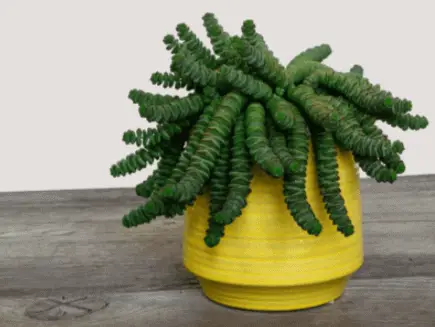
DISCLAIMER
Some of the links on here are affiliate links and I may earn if you click on them, AT NO EXTRA cost to you. Hope you find the information here useful! Thanks.
Related Articles:
- Essential Guide To Philodendron Melanochrysum Care
- Scindapsus Moonlight – Essential Tips You Need to Know
- A Complete Care Guide to Philodendron Giganteum
- How To Propagate Crassula Ovata (Jade Plant) in 8 Simple Steps
- Crassula Perforata: How To Care for the String of Buttons Plant
What Is a Crassula Hottentot?
While its scientific name is Crassula x rupestris f. marnieriana ‘Hottentot,’ it’s more commonly known as the Rosary plant, baby necklace, Chinese Pagoda, and the Jade necklace vine.
It’s a flowering succulent from the genus Crassula of the family Crassulaceae.
This particular Crassula is a hybrid of Crassula rupestris and Crassula perforata, both native to South Africa, Lesotho, Swaziland, and Mozambique. Crassula marnieriana, as it’s scientifically called, is therefore officially regarded as a subspecies of Crassula rupestris.
The name ‘Hottentot’ was given to it as it resembles the hair of the native Khoikhoi people of Southern Africa.
NOTE- As it is now considered a derogatory term, botanists and plant enthusiasts throughout the world are rolling back the usage of the term Crassula Hottentot and calling it by its official scientific name Crassula Marnieriana or one of its many pseudonyms instead.
Crassula succulents can be divided into shrub (branching) varieties commonly known as jade plants and stacked Crassulas with leaves pancaked on top of one another along thin stems.
The Crassula Hottentot and Crassula Tom Thumb are popular stacked Crassulas.
The genus Crassula might actually exceed 200 species. Unfortunately, it can be quite hard to distinguish one Crassula from the other at times. Check out this album by debraleebaldwin.com for an extensively well-documented gallery of the various Crassula species.
A tiny Crassula photo. Baby Groot is patiently waiting for them to grow out.
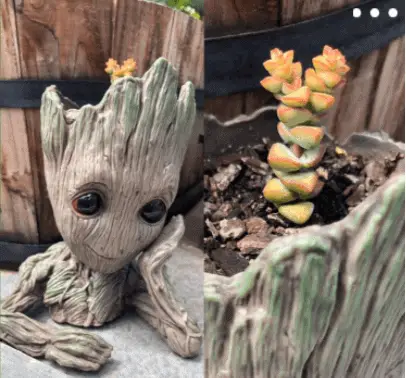
Crassula Tom Thumb. Photo credit: gardentags.com
Features of Crassula Hottentot
Crassula Marnieriana Hottentot is one of the most unique members of the Crassula clan, sporting vertically-stacked plump leaves adorned on the edges with blush pink.
This, in turn, goes crimson red with increased sun exposure.
It’s a slow-growing succulent that can reach a maximum height of around 6-8 inches (15–20cm) before it starts to droop.
Its thick rounded leaves are bluish-green to light green originally and are tightly stacked on top of one another along the stem and store water pretty well. They are covered with a cuticle to limit evaporation, and therefore can last rather long without being watered.
An inflorescence with tiny stellate pinkish-white flowers may appear in the spring or summer in mature plants once a year if the conditions are suitable. These tiny flowers grow to only about 12 inches (30cm) and appear like a tiny bouquet of baby’s breath. Absolutely adorable!

Jargon Buster
- Cuticle: waxy outer layer/skin.
- Inflorescence: Flowering or the process of flowering.
- Stellate: arranged in a radiating pattern, like that of a star.

Potting Needs of Crassula Hottentot
Always plant your Crassula Hottentot in a pot with good drainage holes and in soil that drains well. While it’s considered a rather hardy plant, the biggest danger to your succulent is root rot. If the roots are soaked for any longer than a couple of hours, you’re putting your plant in harm’s way.
The type of pot you choose is also important. Choose a pot that evaporates excess moisture to prevent root rot.
A ceramic pot or a sturdy plastic one will do.
This ceramic pot is so pretty and very affordable, the perfect home for your Crassula Hottentot.
Or maybe you prefer a plastic pot, to avoid accidents if you drop it! This set includes 8 pots for an incredible price.
Transplant or repot only as required when your plant outgrows its pot. Crassula Hottentot is very tolerant of crowded conditions. It has no issues with root crowding. You’ll find many felled tips of the plant forming roots in the soil as the plant expands in volume to the peripheries of your pot.
The Crassula Hottentot and jade plants, in general, are known to be top-heavy, and with their shallow roots, they have a tendency to tip over. So always ensure they have adequate room.
As mentioned above, it’s aesthetically pleasing in a hanging pot but does pretty well in a well-drained pot on a shelf or windowsill with adequate light and room to trail down the sides of the pot.
Soil Conditions for Crassula Hottentot
As it’s native to South Africa and its neighbouring countries where it sprouts directly from the ground, this tough little plant has adapted to grow in sandy, dry and rocky conditions, in soil with low fertility.
You would therefore need to imitate these conditions for it to thrive in your home.
The Crassula Hottentot is very much at home in cactus soil or compost as a houseplant. The best soil is a well-drained mixture of sand or grit with peat and vermiculite or perlite. You can even mix some sand or add gravel through the compost for extra drainage.
If you’re concerned about using peat for the risk of having fungus gnats, use succulent mixes that leave out the peat.
The Imperial Potting Mix, for instance, contains pumice rock, red lava rock, and Orchiata Monterey Pine Bark. You could, of course, purchase these ingredients separately and come up with your own favourite mix that works for you.
Lighting Conditions for Crassula Hottentot
Like many of its fellow succulents in the Crassula family, Crassula Hottentot is considered a sun-loving plant. It needs at least 4-6 hours of sunlight a day to thrive. It prefers bright but indirect light (through a window).
With enough sunlight, they develop the much sought-after pinkish tinge to its edges.
Be wary of the fact that Crassulas do have a tendency to burn if left in the scorching sun for prolonged periods at a time. The leaves will get dry and fall off the stem due to dehydration.
It’s therefore rather peculiar that it thrives in the dry open plains of Southern Africa under direct sunlight all year round, but when kept as a houseplant, it gets quite finicky.
Place your plant in an area where it can receive morning sunlight for a couple of hours a day, filtered through a window, and protected from the full brunt of the midday sun.
When starved of light, the plant will stretch out or become elongated with lots of room between its stacked leaves. When this happens, it’s a sign you need to move your plant to an east-facing windowsill for that well-earned morning sunbath.
Watering Schedule For Crassula Hottentot
Like its succulent siblings, Crassula Hottentot needs very little watering as it stores the water in its fleshy leaves. It’s imperative to always check the soil before watering.
Only water the plant when the soil feels completely dry to touch.
Alternatively, use a moisture measuring device to determine if your plant needs watering. Take extra care to make sure you water only the soil and not get any water on the leaves. Use a plastic squeeze bottle with a funnel to direct the flow.
If you were wondering which moisture measuring device is the best option for you, I recommend this affordable option.
And don’t forget to buy the plastic squeeze bottle, here you can buy 2 for the price of one.
Use a tray under your pot. Make sure you pour away any excess fluid on the tray and wipe it dry before replacing it. Allowing water to accumulate on the tray might put your plant at risk of root rot.
Take every step possible to prevent this from happening. It’s basically a death sentence to your plant.
Once watered well, you probably won’t need to water again for at least two weeks, depending on the humidity. Check the topsoil regularly and only consider watering the plant if the soil is completely dry to touch.
In summer, water your Crassula Hottentot once a week, and in the winter, once every three weeks should suffice.
The best time to water your plant is in the morning. Water it generously and allow the excess fluid to drain out onto the tray. Let the plant have enough time to dry out in the morning sun and clear out the tray by midday.
Finally, fret not if you’re going to be away during the summer and won’t be around to water your Crassula Hottentot. It’s rather drought-resistant and can go for weeks without being watered.
Seasonal Considerations for Crassula Hottentot
During winter, place your Crassula Hottentot indoors where it can get lots of sun and is relatively warm. Be sure to move it indoors before the first frost. Avoid leaving it out in temperatures below 500F (100C).
During summer and warmer weather, you can move the plant outdoors, but do this in stages. Gradually increase its time outside and in direct sunlight, patiently letting it get acclimatized to its new surroundings.
If the air is too dry, the leaves will lose moisture and shrivel up and even drop. So, in addition to keeping the soil lightly moist, good ventilation and a fair amount of humidity are equally important.
If the air in your home is on the dry side due to the use of air conditioning or electric heat, consider using humidity trays to keep the plant’s leaves hydrated at all times while avoiding the risk of overwatering.
It is crucial to maintain moisture levels around your Crassula Hottentot between watering sessions, and these trays help accomplish that. Simply spread decorative pebbles onto the tray and add sufficient water. Place your Crassula on top and breathe a sigh of relief.
As the water slowly but surely evaporates, the humidity around your plant will increase and stay that way for the dry winter months.
On the flip side, increased humidity is considerably more harmful to your Crassula as it once again carries the risk of causing root rot. If you find drops of condensation on your windows, it’s probably best you move your plant further away from that windowsill.
Care Routine for Crassula Hottentot
Although it has a reputation of being a demanding succulent, the level of Crassula Marnieriana Hottentot care is still considered minimal and suitable for beginners.
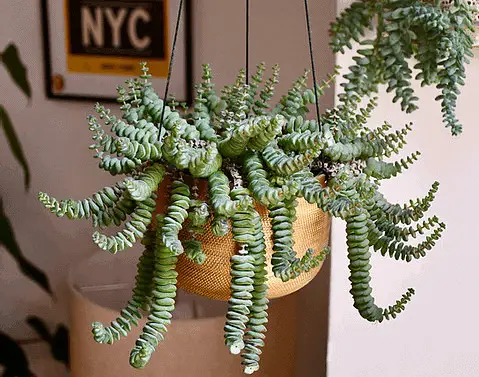
Crassula Rupestris care doesn’t take too much time or effort at all. Be sure to water only when the soil is totally dry and keep the conditions optimum. That includes adequate sunlight and warmth.
Feeding your Crassula houseplant with succulent food will also benefit it greatly during the growing seasons.
Crassula Hottentot has a pretty fast growth rate, and you might therefore want to consider trimming its stems to make babies or repotting every 2-3 years.
As mentioned above, if all your stars are aligned, and you’ve got all these optimum conditions (warmth, light, water), there’s a good chance you’ll see pinkish-white flowers blossom over the growing months.
How to Propagate a Crassula Hottentot?
Crassula Hottentot is one of the easiest succulents to propagate. All you need to do if you’re planning to make little Crassula babies are:
- Cut off a couple of the stems using a clean pair of scissors. Take a few cuttings just in case they fail to root. Snip it right above a node with at least one node above your cut.
- Remove a few of the leaves at the bottom of your cutting, leaving a few younger, smaller stacked leaves intact above them.
- 1. Let it dry out overnight to prevent root rot.
- 2. Dip your stem tips in rooting hormone (optional) to give it that extra chance to take root and speed up the entire process.
- 3. Place your cuttings into a well-draining potting mix and place the pot away from direct sunlight.
- 4. Water gently or mist the soil every 2-3 days to keep it hydrated.
- 5. New roots should start setting in by 2-3 weeks, and your babies will be completely rooted and all grown up within 4-6 weeks.
- 6. You should be able to see new leaves stacking up at the top as well as growth on the top and sides of the stem cutting.
- 7. I wouldn’t recommend doing this, but you might feel some resistance when you tug your plant lightly, a sign that it has taken root.
- 8. As the plant matures, expose it to more sunlight gradually and reduce your watering frequency to about once a week.
For a quick and easy guide to propagation and more Crassula Hottentot care tips, check out this video by Succulent Box.
Tackling Pests and Diseases in Crassula Hottentot
It’s quite a hardy plant, and rarely would you come across any problems regarding pests and diseases.
Mealybugs are nasty little critters that nibble at the new growth on succulents. So, if you’re wondering why your tiny new leaflets at the top of the stack are looking distorted and weird, you probably have a problem with mealybugs.
You can remove mealybugs using a cotton bud dipped in alcohol. The other alternative is using a good horticultural soap spray. Be extra gentle, though. If left untreated, mealybugs can spread to the entire plant and to nearby succulents too.
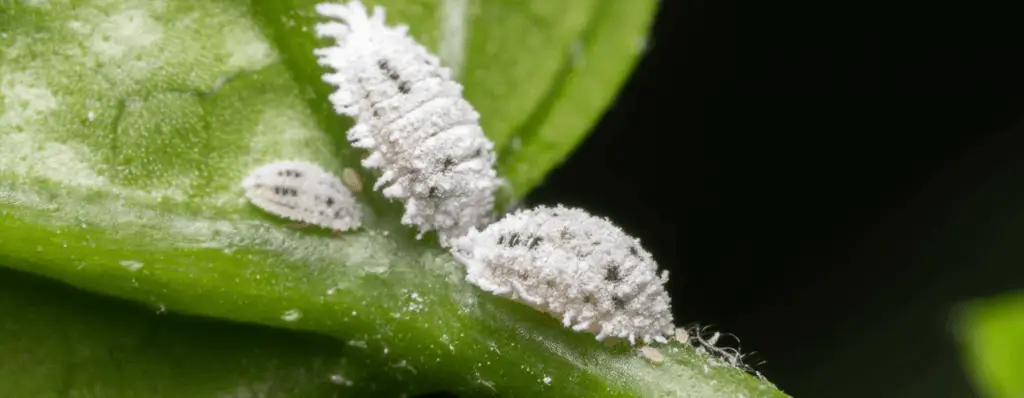
Problems You Might Face With Crassula Hottentot
As it’s a fairly easy plant to deal with, there aren’t many serious issues when it comes to Crassula Hottentot care.
Probably the only problem would be a lack of growth, and this goes for succulents in general. It’s highly likely you are overwatering your Crassula.
Always check to make sure the soil is totally dry before watering, even if it has been a couple of weeks since you’ve last watered it. Overwatering is the most common reason for a dying Crassula.
If you’re wondering why the colour isn’t as pink or red as you thought it’d be, that’s usually due to a lack of sunlight.
Famous Family Members of Crassula Hottentot
More commonly known as Green Jade, this is an extremely popular houseplant and is readily available in nurseries worldwide. Like most succulents, it requires little water and cares in general.
Newer cultivars are more interesting and high in demand as they are just as easy to grow and are more attractive. They come in different shapes and variegation. A popular cultivar would be the Crassula ovata Gollum.
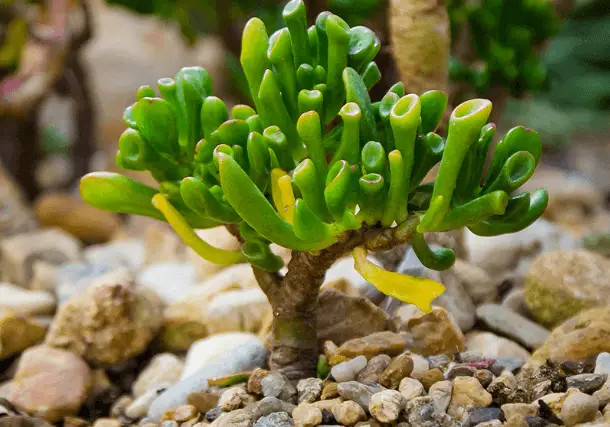
Jargon Buster
- Cultivar: Any new plant that comes about in cultivation. Plants are selected for certain desirable characteristics that are maintained during propagation.
- Variegated: multicolored, especially as irregular patches or streaks.
Also called the wooly Crassula, this succulent can grow up to 2 feet (61cm) in height. It’s characterized by its greyish-green leaves with woolly hairs on its outer rims that take up a rosette formation.
These pretty rosettes form compact clumps and make for a gorgeous potted gift. It has a dwarf version called Crassula tomentosa var. glabrifolia.

Also known as the lizard skin Crassula, this rare crassula has a white lizard-skin texture on its oval-shaped leaves. This succulent has a basal rosette and sends branches of its plump leaves in every direction.
Their white colouration reflects heat away and makes them tolerant to harsh conditions. They are more susceptible to root rotting than other crassulas and should be watered minimally.

FAQs
- Is The Crassula Hottentot Toxic To Pets?
While it’s not known to be toxic to humans, Crassula Hottentot can be toxic to both cats and dogs. It’s advisable to keep them away from pets and children.
- Do Crassula Plants Need Sunlight?
Yes, they do. Crassula Hottentot, in particular, thrives in an environment with at least 4-6 hours of indirect sunlight a day. The outer rims of their leaves turn pink with added sun exposure, and they will only flower if they receive adequate sunlight.
- Is Crassula Hottentot An Indoor Plant?
While its natural habitat is out in the harsh, dry plains of Southern Africa, Crassula Hottentot has taken very well to being a domesticated houseplant. It thrives indoors, hanging on your balcony or your windowsill, and needs adequate indirect sunlight.
So, yes. It is an indoor plant and is probably easier to care for while indoors, where the conditions can be easily managed.
- How Often Do You Water Crassula Hottentot?
As mentioned in detail above, there is no hard and fast rule when it comes to a watering schedule for your Crassula Hottentot or any succulent, for that matter.
Always check to make sure that the soil is dried out before you water it. Root rot is the bane of any amateur plant enthusiast, and overwatering is its primary cause. As an average but not a general rule, water your Crassula Hottentot once a week in the summer. In the winter, once every three weeks should suffice.
- Where Do You Keep A Crassula Hottentot In The House?
As it requires at least 4 to 6 hours of indirect sunlight a day to thrive, keeping your Crassula Hottentot on an east-facing window sill or balcony will allow it adequate morning sun and stay protected from the harsh rays of midday.
Conclusion
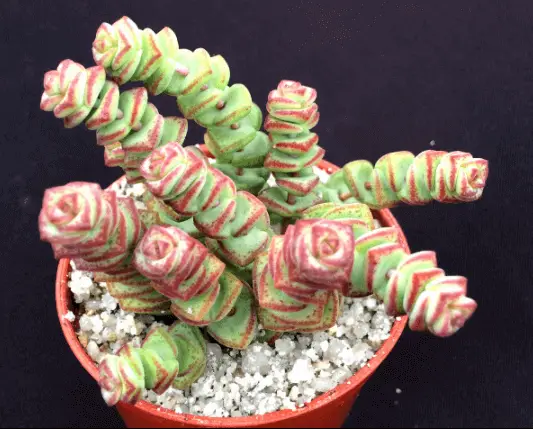
If you’re a newfound succulent fanatic or a seasoned collector, this particular gem will definitely be on your radar. It has to be one of the more aesthetically pleasing of the succulent clan.
The unique geometric patterns and eye-catching colour combinations; it’s a fashion statement for any room or balcony.
Plus, it’s easy to care for and looks great if left alone in a hanging pot for weeks on end. If that isn’t more of a reason enough to love the Crassula Hottentot, did you not notice its cute little flowers? It’s certainly one of my favourite succulents. What’s yours? Do tell me in the comments below.







![How To Trim Basil Plant Without Killing It & What To Avoid! [2023]](https://aboveandbeyondgardening.com/wp-content/uploads/2022/10/how-to-trim-basil-plant-without-killing-it-768x513.jpg)
![How To Grow Tomatoes Indoors With Lights + Growing Tips! [2023]](https://aboveandbeyondgardening.com/wp-content/uploads/2022/08/how-to-grow-tomatoes-indoors-with-lights-768x512.jpg)
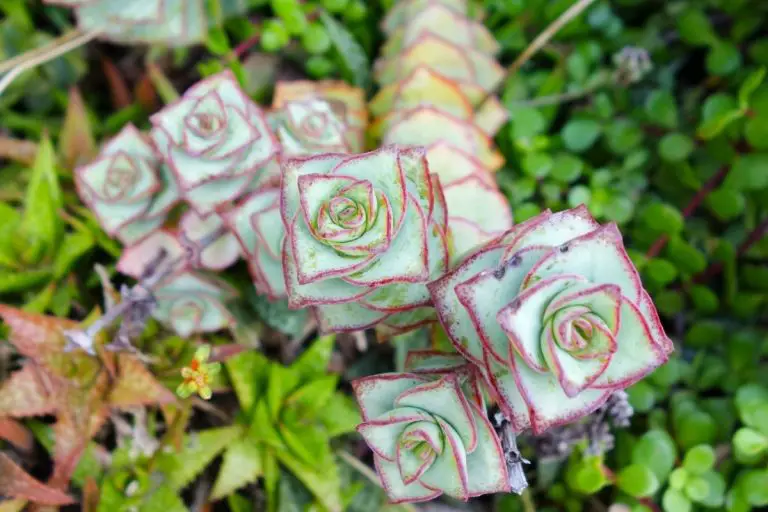
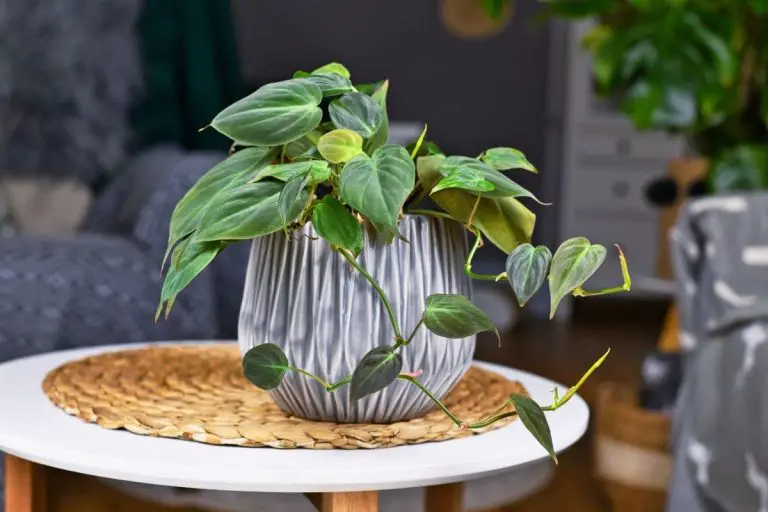
![Why Are Pink Princess Philodendrons So Beloved? – Care Tips [2022]](https://aboveandbeyondgardening.com/wp-content/uploads/2022/02/Why-are-Pink-Princess-Philodendrons-so-Beloved_-768x512.jpg)

